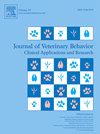Perceptions, behaviours, and practices of dog owners for giving treats: A cross sectional investigation
IF 1.3
3区 农林科学
Q4 BEHAVIORAL SCIENCES
Journal of Veterinary Behavior-clinical Applications and Research
Pub Date : 2025-01-25
DOI:10.1016/j.jveb.2025.01.007
引用次数: 0
Abstract
Steady worldwide growth in commercial treats production and sale shows the importance of pets, such as dogs, in human life and the great attention of owners to the health of their pets. The owners buy such goods not only for their nutritional value but also to strengthen their bond and interest with pets. Regarding the importance of treats in pet dogs’ health, and on the other hand, its relationship with some diseases such as obesity, the frequency of treat consumption and related factors were evaluated for the first time in Iran in this cross-sectional study. To that end, data were randomly collected from 659 dog owners in 7 cities of Iran, including Ahvaz, Tehran, Karaj, Sari, Mashhad, Kermanshah, and Urmia, using a questionnaire. Statistical analysis of data was performed using SPSS software version 22, and the relationship between treat consumption and independent variables was determined using the Chi-square test and logistic regression. The relative frequency percentage of information about treats and the frequency of treat consumption were 92% and 88%, respectively. Treat consumption in multivariate logistic regression also had a significant relationship with the dog owner's education (P≤0.05), breed (P≤0.001), lengths of dog ownership (P≤0.05), dog’s weight control (P≤0.01), and the dog’s BCS (P≤0.01). Although knowledge of the treat’s components, such as protein, fat, and sugar, was acceptable to dog owners, there was little knowledge of the possibility of microbial and fungal contamination in the treats. Nearly half of the owners were unaware of the relationship between treats and diseases, especially obesity, digestive, and endocrine problems in dogs; this case highlights the importance of veterinarians as a reliable source of information for dog owners in Iran. It is clear that increasing the owner's knowledge about treats has led to a change in attitude and practice, and accordingly, can affect the dog's health and the owner’s comfort.
Data availability
The data that support the findings of this study are available from the corresponding author upon reasonable request.
求助全文
约1分钟内获得全文
求助全文
来源期刊
CiteScore
3.50
自引率
16.70%
发文量
107
审稿时长
325 days
期刊介绍:
Journal of Veterinary Behavior: Clinical Applications and Research is an international journal that focuses on all aspects of veterinary behavioral medicine, with a particular emphasis on clinical applications and research. Articles cover such topics as basic research involving normal signaling or social behaviors, welfare and/or housing issues, molecular or quantitative genetics, and applied behavioral issues (eg, working dogs) that may have implications for clinical interest or assessment.
JVEB is the official journal of the Australian Veterinary Behaviour Interest Group, the British Veterinary Behaviour Association, Gesellschaft fr Tierverhaltensmedizin und Therapie, the International Working Dog Breeding Association, the Pet Professional Guild, the Association Veterinaire Suisse pour la Medecine Comportementale, and The American Veterinary Society of Animal Behavior.

 求助内容:
求助内容: 应助结果提醒方式:
应助结果提醒方式:


